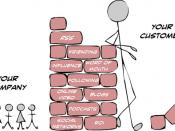Retail is one of the more visible market sectors on the Web. In retail, merchants sell products and services directly to a buyer. E-retail, also called e-tail, occurs when retailers use the Web to sell their products and services (Sanchez 16). E-retailers constantly challenge the old ways of conducting business as they bring new products and services to market. All e-retailers, however, operate in a similar manner.
A customer (consumer) visits an online business at the Web equivalent of a showroom: the electronic storefront. An electronic storefront, also called an online catalog, is the Web site where an e-retailer displays its products. It contains description, graphics, and sometimes product reviews. After browsing through merchandise, the customer makes a selection. This activates a second are of the store known as the shopping cart. The shopping cart is a software component on the Web that allows the customer to collect purchases.
Items in the cart can be added, deleted, or even saved for a future visit.
When ready to complete the sale, the customer proceeds to the checkout. At this time, the customer enters personal and financial data through a secure Internet connection. The transaction and financial data automatically are verified at a banking Web site. If the bank approves the transaction, the customer receives an online confirmation notice of the purchase.
Then, the e-retailer processes the order and sends it to the fulfillment center where it is packaged and shipped. The e-retailer notifies the bank of the shipment, and payment is sent via electronic channels to the e-retailer. Inventory systems are updated. Shipping information is posted on the Web, so the customer can track the order. The customer typically receives the order a few days after the purchase (Microsoft Word 2002 Project 2).
E-retailing presents a new way...


